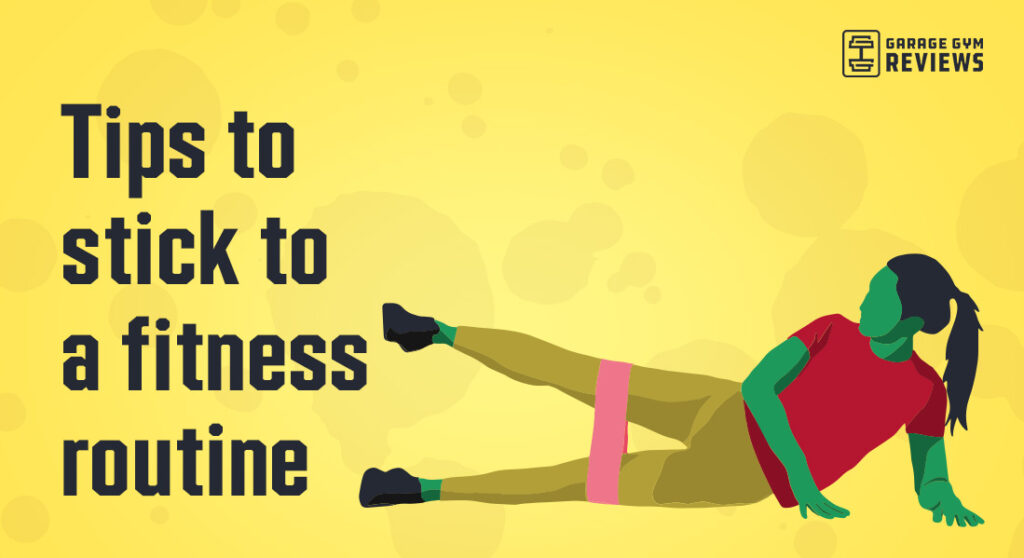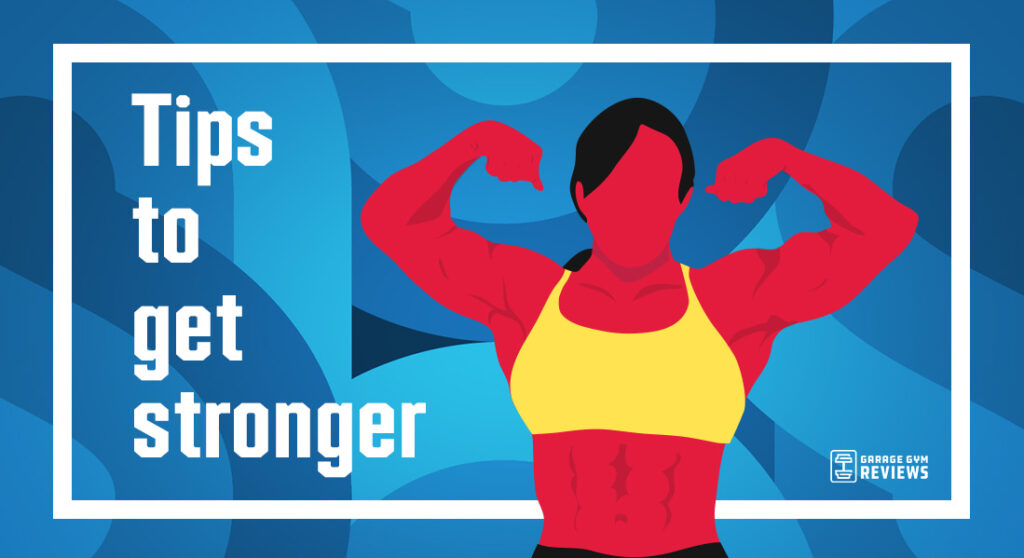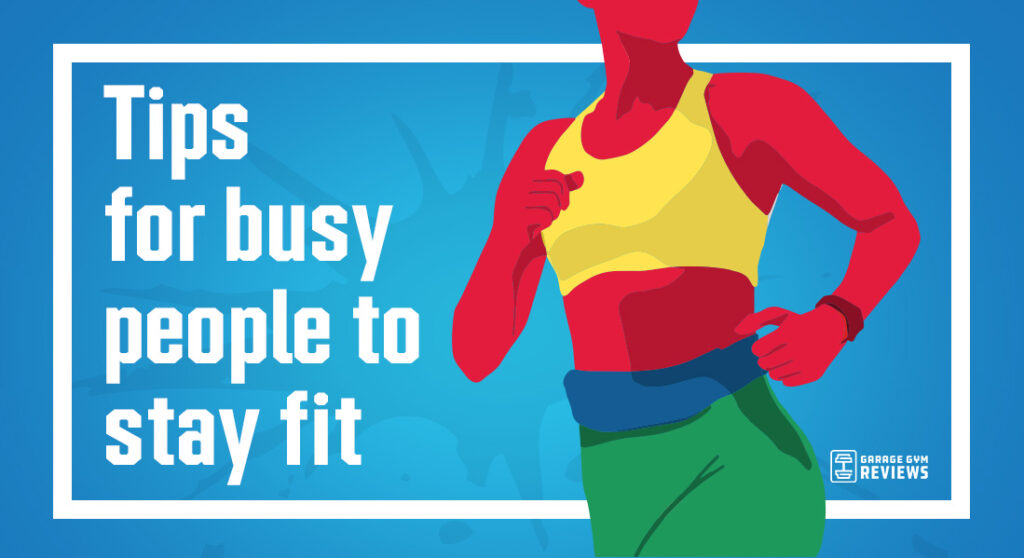Whether you’re a beginner just starting your fitness journey, or you’re a longtime fitness enthusiast chasing after some new, big goals, it can be overwhelming to figure out a plan and prioritize.
We’re taking the guesswork out of your fitness routine so you can stop thinking and start working. Our fitness and nutrition experts each share 10 to 12 fitness tips for reaching—no, crushing—your fitness goals.
Here’s what we’re dishing out:
- Lauren Strong, GGR writer and NSCA-certified personal trainer, discusses how to make fitness a habit rather than a to-do item.
- Caine Wilkes, GGR writer and elite weightlifter who competed at the 2020 Tokyo Olympics, shares his best advice for getting stronger.
- Amanda Capritto, GGR senior writer, certified personal trainer, and triathlete, provides tips for building endurance.
- Anthony O’Reilly, GGR performance editor and certified nutrition coach, gives his best tips for eating a healthy diet that fuels your goals.
- Frieda Johnson, longtime fitness and nutrition editor, writes about the importance of sleep and how to improve yours
- Kate Meier, GGR Head of Content, certified personal trainer, and USA Weightlifting coach, offers fitness tips for busy people
- Nicole Davis, GGR senior editor, certified personal trainer, and mom of two, shares her top tips for working out when you have kids.
10 Tips to Stick to a Fitness Routine
Before we start talking about how to get stronger or how to run faster, we have to cover the unsexy part of fitness: actually making it a habit. Take it from Lauren Strong, GGR staff writer and certified personal trainer, who offers tips on how to integrate fitness into your everyday life.

Tip 1: Start With Baby Steps
If you’re just starting a fitness routine or rebuilding one, take one small baby step at a time. As a certified personal trainer, I often see clients set lofty goals and try to push themselves too hard during the first week. Starting out is exciting, but it’s just the beginning. There will be time in the future for epic leg days and personal records—the beginning is all about setting a foundation.
Tip 2: Do Workouts You Enjoy
So you don’t like CrossFit? That’s okay, there are plenty of ways to train for strength, endurance, and overall health. When it comes to exercise, there are dozens of ways to find enjoyment. Perhaps yoga is more your pace versus barbell deadlifts and squats—or maybe you’re a resistance band kind of person. There is no shame in liking one method or style of fitness more than another. It also might take some experimenting—with reps, sets, weight, classes, apps, or trainers—to discover what you really enjoy.
Tip 3: Set Obtainable Goals
Goal-setting is important with a fitness routine because it keeps you focused and accountable to achieve those goals. The one thing I’ve found (with myself and clients) is the fact that it’s easy to set a big lofty goal, but it’s much harder to break that goal down into bite-size pieces and make it happen. If your goal is to back squat your bodyweight, you’ll have to break that down into weekly or monthly goals starting from where you’re at now and map out small steps on how you’re going to squat your goal weight.
Tip 4: Try Not to Skip More Than One Workout
Skipping workouts is a slippery slope. Life happens, and it’s not uncommon to need to skip a day in a training cycle for work, a social event, or travel. Skipping more than one or two sessions often derails your routine and it can be tough to get back on track. That said, if you find that you are skipping workouts, it’s worth examining your current routine and asking yourself what’s working and what’s not working.
Tip 5: Set Rules That Work For You
This goes hand-in-hand with starting with baby steps and creating attainable goals—you want to set up a few rules or promises to yourself that you know you can keep. If your rules are too strict and rigid with no wiggle room or gray area, it’s going to be hard to follow them.
Tip 6: Make Movement Part of Your Life
For heart health, the CDC recommends that adults get at least 150 minutes of moderate to vigorous exercise every week. When you break that down, that might only mean about 20 minutes of exercise per day.
However, there is no hard-and-fast rule about what type of movement you have to do. If you like walking better than running, that’s cool. If you like yoga more than lifting weights, that’s cool, too. In general, a mix of resistance training and cardiovascular exercise is ideal for heart health and overall muscular strength, but it’s up to you to decide what works best.
Tip 7: Be Consistent
Being consistent can be hard. We’re all busy people with complex and chaotic schedules. It’s important to have a fitness routine that works with your schedule and allows you to be consistent. If you’re not a morning person, it’s going to be hard to stay consistent if the time of day does not align with how your day functions.
Tip 8: Something is Better Than Nothing
Some seasons of life are just plain hard, and when life feels hard, sometimes taking care of yourself is nearly impossible. However, exercise doesn’t have to be all-or-nothing. If you’ve been crushing hour-long workouts but lately it seems like you just can’t do it, try 20 minutes of light movement, such as a walk, instead.
Tip 9: Measure and Track Progress
You know that feeling of receiving a compliment that totally turns your whole week around? One little nugget of positive reinforcement can make us feel pretty darn good. So what if you could deliver compliments to yourself every week with your own training progress?
For example, if you log your workouts in a journal or training app—like recording your mile time or weight lifted on a bench press—you can look back at your progress and see just how far you’ve come. It’s like a pat on the back for showing up and putting in the effort each week.
Tip 10: Try to Choose the Same Days and Times
Forming habits takes time, dedication, and serious conscious thought, too. One study1 suggests that habit formation is more likely to happen when the new behavior is performed within the same context (typically the time of day and location).
For example, if you frequently and consistently make a habit of walking in the morning after a cup of coffee, over time, that morning walk will feel effortless and habitual rather than feeling like an item you need to check off of a to-do list.
12 Tips to Get Stronger
Caine Wilkes, an elite Olympic weightlifter who competed at the 2020 Tokyo Olympics (and placed ninth!), shares his best advice for getting stronger.

Tip 1: Dial in Technique First
Training to build strength might seem like an aggressive, rage-fueled endeavor, and at times it is (depending on the athlete). However, these athletes built their training on a solid foundation of technique before cranking up the weight. Anyone new to strength training should prioritize the technical aspects of an exercise before adding much weight at all. Slow down, keep the weights light, and focus on good movement patterns before ramping up the weights to a new max.
Tip 2: Increase Resistance Progressively
The easiest way to see progress in lifting weights is seeing the weight on the bar go up. We do this by implementing progressive overload, or increasing the resistance incrementally. If you’re training sets of five at the time, try five or ten more pounds than last week. Increased resistance forces muscles to adapt, thereby increasing strength.
Tip 3: Address Your Weaknesses
You could have a strong lower body but a weak upper body, and that can hinder your squats and deadlifts, among other exercises. To be an all-around stronger athlete, we have to address those weaknesses. Throw in a couple of accessory exercises to work on weak core muscles or smaller stabilizing muscles at the end of a workout. Addressing muscle group weaknesses will help you maintain better form throughout a heavy lift.
Tip 4: Keep a Workout Log
Getting stronger can take time; it’s smart to track your progress with a log. Whether an app on your phone or a handwritten journal, keeping a workout log helps you see what exercises are progressing and how well. Once you have a month or more of days logged, it will be easy to tell what things are working, what needs adjusting, and how much progress you have made over time.
Tip 5: Spread Out Your Heavy Days
Heavy lifting can tax the central nervous system, so make sure you have enough time between heavy days and exercises to properly recover for the next one. Keep heavy lifts like squats, cleans, or deadlifts a few days apart, broken up with low-intensity days and weights.
Tip 6: Train Hard, Recover Harder
It’s important to train hard, but if you’re not allowing yourself time to recover, you will not make the progress you could be making. According to a 2017 study2, training without adequate rest can increase your likelihood of injury. Put the same effort into your recovery: stretch out regularly and roll out sore muscles. Make sure you’re getting enough sleep, eating right, and also taking supplements where needed. This is to say: Don’t skip your rest days!
Tip 7: Fuel Yourself For Maximal Strength Gains
Working on strength training takes a lot of effort, so make sure you are fueling your body properly. First off, eat enough calories to promote muscle gains. Eat a high-protein diet, along with quality carbohydrates and healthy fats to ensure your body can properly fuel your muscles.
Tip 8: Use Supplements to Fill any Gaps
It’s difficult to meet all of our nutritional needs from foods alone, so supplements can help satisfy any needs lacking from our current diet. A protein shake can help getting adequate protein intake on the go, whereas creatine and BCAAs can help support muscle repair and growth.
Tip 9: Improve Your Mobility
Getting low in a squat with good form requires more than just strength. It requires balance, coordination, and flexibility. You will get the most out of your strength training if you are able to perform the full range of motion, so you need to train for mobility. Through proper stretching and warmups addressing mobility issues, you can strengthen lifting positions, which will inevitably strengthen you.
Tip 10: Save Your Cardio For After Lifting…Or Not
It’s best not to run a mile or row a marathon right before your squat max. Running any distance at maximal effort before maximal strength training can dramatically decrease your performance.
However, a recent study3 showed that 20 minutes of cardio prior to resistance training actually boosted muscular growth more than simply weight training alone. So, as a warmup, a bit of cardio might pay off, but as a rule of thumb, it’s best to save a long cardio workout for after lifting, or even on a separate day.
Tip 11: Vary Your Training
Just like you shouldn’t do the exact same sets and reps every training session, you should also vary the exercises you are doing. Squats are great to build leg muscle, but you’ll see even better strength gains if you do some squat variations or core accessories in addition to your main strength exercise. Instead of barbell deadlifts, try it with dumbbells or a resistance band. Keeping it a little different also keeps training fun and challenging!
Tip 12: Remember, It’s a Process
I’ve been to the Olympics, but it didn’t happen overnight. It was a long process of being consistent and smart in my training in order to make gains and get stronger over time. It’s good to remind yourself of this sometimes, like on a rougher training day. Changes don’t happen just in a day or two. Be consistent, train smart, and recover properly, and over time you will see the progress you’re looking for.
11 Tips to Build Endurance
Looking to run, cycle, hike, or walk longer—but stay fast? Then you should prioritize endurance training. These tips from Amanda Capritto, GGR senior staff writer, certified personal trainer, and triathlete.

Tip 1: Remember That More Distance Isn’t Always Better
Obviously, in order to run, walk, or bike longer distances, you’ll need to progressively overload your distance training. But don’t make it all about distance, all the time. Pepper in other forms of training, such as the types as we’ll cover here, to build endurance more efficiently.
Tip 2: Utilize Interval Training
HIIT may seem overhyped at this point, but only because it actually works: Studies4 show time and time again that interval training is one of the most time-effective methods for building both aerobic and anaerobic capacity—and you need both to be a well-rounded endurance athlete.
Tip 3: Don’t Neglect Strength Training
Want to get better at climbing hills on your bike or put more power behind each stride on your runs? Then you need to be in the weight room as well as out on the trails. Strength training has been proven5 to improve long-term (greater than 30 minutes) and short-term (15 minutes or fewer) endurance capacity in new athletes and elite athletes alike.
Tip 4: Prioritize Lower-Load, Higher-Volume Workouts
Making time for weight training doesn’t necessarily mean maxing out your lifts, although that type of training does assist with power output in endurance athletes. Higher-volume training with lighter weights is the best way to increase muscular endurance, which largely dictates how long you’re able to perform a specific movement pattern with success. You’ll also build muscle while you’re at it.
Tip 5: Do Tempo Workouts
If you want to run, cycle, walk, or hike for long periods of time, your muscles must be able to handle long periods of work and stress. This is why you should add tempo training to your routine, a style of weight training that intentionally slows down the eccentric (and sometimes the concentric) phases of an exercise.
Forcing your muscles to slow down under an external load, like a barbell with weight plates, will improve their ability to handle extended periods under duress. (And it’s not bad for developing explosive power6 and muscle mass7, either.)
Tip 6: Learn to Eat for Endurance
Those who decide to get serious about endurance training often find themselves surprised at nutrition recommendations for endurance sports. Everything you know about healthy eating is thrown out the window—you’ll be told to eat Pop Tarts before training sessions, drink sugary, salty solutions instead of water, and keep candy on hand at all times.
This is because quick-digesting carbohydrates are essential for prolonging endurance performance. When you’re out on a two-hour bike ride, a protein shake won’t cut it (at least, not if you want optimal performance). Your muscles need carbohydrates for fuel, and they need it fast, hence the easy-to-digest sources.
Of course, it’s still important to eat a lot of nutrient-dense foods and have a balanced diet. This type of advice applies only to pre- and intra-workout fuel.
Tip 7: Decrease Recovery Intervals
One simple tip for increasing endurance is to reduce the amount of time you rest between sets, whether you’re in the weight room doing squats or performing 400-meter repeats on the track. Over time, you can train your muscles to put out equal power with less rest.
Tip 8: Find Hills and Stairs
Introduce incline training to your routine, whether your activity of choice is running, biking, or something else. Incline training strengthens the muscles and exposes your body to new challenges, forcing them to adapt.
Tip 9: Vary Your Routine and Terrain
Routine is the enemy of the endurance athlete. Trying new workouts on different surfaces forces you to engage your body differently, which may translate to better performance once back on your typical terrain. For instance, one study8 found that running on soft sand induces different physiological adaptations than running on a firm surface, like the road. Take this as your sign to enjoy a beach run or a trail run every so often.
Tip 10: Train Under Fatigue
For those who struggle with strong finishes, whether in races or during training sessions, training under fatigue is a good strategy. This basically means do more when you’re already tired or taxed. An example is to run after your strength training session, or do your sprinting intervals after your strength session. This will improve your mental and physical capacity for aerobic work.
Tip 11: Combine Strength and Cardio Into One Workout
This tip kind of combines many of the others for building endurance. Combining strength and cardio into one workout helps you maintain variety, train under fatigue, and build strength and muscular endurance.
12 Tips to Eat More Nutritiously
You wouldn’t put the wrong type of fuel in your car, so why do it to your body? Here are some helpful tips to eat more nutritiously from GGR performance editor and certified nutrition coach Anthony O’Reilly.

Tip 1: Focus on High-Volume, Low-Calorie Foods
A perfect example of high-volume, low-calorie foods are blueberries—100 grams is just under 60 calories, chock full of vitamins and minerals, and is a considerable amount of food. By comparison, a 50-gram serving of your standard potato chips can be nearly 300 calories and high in saturated fat, and you’ll probably still be hungry because you only had a handful.
Tip 2: Cut Out (Most) Added Sugar
Excess sugar intake has been linked to a number of diseases9, such as heart disease and Type 2 diabetes. An easy way to reduce your added sugar intake is to look for sugar-free condiments, beverages, and other food items, which will also drastically reduce your calorie intake.
Tip 3: Drink More Water
Not only is hydration vital to a number of bodily functions, but studies10 have actually shown that some people may mistake thirst for hunger. The next time you’re hungry, try drinking a glass of water and see if that quenches your craving—if not, then go ahead and have a snack or meal.
Tip 4: Eat Protein With Every Meal
Protein is the most filling macronutrient11 (the other two being carbs and fats), so adding it to every meal can actually help reduce the number of calories you eat in a day. This can be as easy as adding chicken or steak to a plate of nachos or drinking a protein powder shake with dinner instead of plain water.
RELATED: Our Experts Reviewed Top-Rated Protein Powders
Tip 5: Have Food In Your House at All Times
Keeping food in your house will reduce the likelihood of you running to the grocery store or a fast food restaurant and picking out something that might not be in the best interest of your goals. Keep your fridge, pantry, and freezer stocked with your favorite food items.
Tip 6: Eat That Cake (In Moderation)
It’s your birthday and your coworkers surprised you with a red velvet cake, so what are you supposed to do? Eat it, that’s what.
Studies12 have repeatedly shown that people who restrict certain foods are less likely to adhere to an eating plan than those who occasionally (that’s the key word) indulge in their cravings. A good rule to keep in mind is 80/20—80% of your diet should be whole food sources and the other 20% can be whatever you want.
Tip 7: Consider Supplementation
Supplements can help fill any nutritional gaps in your diet, but that doesn’t mean you should simply reach for the nearest multivitamin. Instead, consult a nutritionist or physician to see if there are any vitamins or minerals you’re deficient in and how much of each you should take.
Tip 8: Shop the Frozen Food Aisle
Frozen foods are just as nutritious as their fresh counterparts, and they have the added benefit of lasting much longer. Utilizing frozen foods can help you keep fruits, vegetables, and other food items on hand at all times.
Tip 9: See if You Have Any Unknown Food Sensitivities/Allergies
Eating foods that you’re allergic to, even if it’s a slight allergy, can cause digestive issues or other health problems that could affect your overall health. Speak to a physician or nutritionist to find out how you can uncover any unknown sensitivities to things like dairy, gluten, soy, and other common allergens.
Tip 10: Don’t Be Afraid of Trying New Foods
Instead of trying to choke down chicken, broccoli, and rice every day, look to see if you can introduce new foods to your diet. This will give you something to look forward to and make sticking to your diet a little easier.
Tip 11: Be Smart When Eating Out
One night on the town won’t kill your progress, but if you find yourself eating out more often than not, you can still be smart about your eating habits by following some of our prior tips: add protein to every meal (i.e. putting chicken or steak on nachos), drink plenty of water, and eat high-volume, low-calorie foods. You can also see if a restaurant will grill your food instead of frying it.
Tip 12: Get Sleep
Sleep is vital to human function, especially when it comes to our diet. People who don’t get seven to nine hours of high-quality sleep are more likely to overeat and make poor dietary decisions, according to some studies13.
Speaking of sleep…
10 Tips to Get Better Sleep
Not getting a good night’s sleep can negatively affect everything in your day, from your ability to focus at work to your athletic performance. If you’re struggling to sleep, try these tips for better sleep hygiene from Frieda Johnson, longtime nutrition and fitness editor.

Tip 1: Stick to a Sleep Schedule
If you’re regularly finding yourself lying in bed at night, struggling to fall asleep, you might want to make sure you’re sticking to a sleep schedule. Not only does going to bed and getting up at the same time every day help you better plan out your time each day, but a 2016 study14 found it drastically reduced the amount of time it took the participant to achieve sleep by ensuring a consistent bedtime and wake up time.
Tip 2: Cut Out Tech at Least 1 Hour Before Bed
According to a 2019 study15, research indicates that blue-light emitting tech like laptops and smartphones can disrupt your ability to sleep and cause poor sleep quality. Everyone is different, so the amount of time you should stop using anything with a screen before bed will depend on you, but personally I’ve found that one hour seems to make a noticeable difference in how long it takes me to fall asleep.
Tip 3: Don’t Consume Caffeine Late in the Day
Caffeine tolerance is highly personal and some people can drink coffee right before bed and have no trouble sleeping—others, not so much. If you’re struggling to sleep and you frequently consume caffeine in the late afternoon or evening, try cutting it out, or at least cutting back. If you don’t think you can make it through the afternoon without your cup of coffee or pre-workout, try swapping it for a cup of green tea or something else with a lower caffeine amount.
Tip 4: Drink a Cup of Herbal Tea
Both camomile and lemon balm are known for their calming effects, which is why they’re often found in “Sleep Aid” blends of herbal tea. Not only can the tea itself help you relax and feel more calm, the act of sipping on a warm (sugar-free!) beverage in the evening can help you unwind as part of an evening routine.
Tip 5: Add Meditation or Yoga to Your Bedtime Routine
Meditation and yoga are both great ways to unwind and relax and there are lots of great resources out there that have yoga flows or meditations specifically designed to help you prepare for better sleep. Even well-known fitness apps like Peloton and iFIT have yoga and meditation options you can try.
Tip 6: Invest in a Good Mattress
If your mattress is uncomfortable, chances are you’ll be tossing and turning at night no matter how on top of your routine you are. Finding the best mattress for your specific needs can go a long way toward getting better sleep. The same goes for your pillow and sheets; if your pillow hurts your neck or your sheets are itchy, you’ll lose valuable sleep time trying to get comfortable. You spend a significant amount of time in your bed, so make sure you’re setting yourself up for the best possible sleep.
Tip 7: Stop Eating Sugar at Least One Hour Before Bed
Much like staring at a screen, consuming too much sugar could also negatively affect your sleep quality, according to a 2019 study16. Again, one hour is my personal cutoff and everyone’s “sweet spot” will be different, but an hour is a good place to start.
To be clear, the study was about overall sugar consumption, so if you’re eating too much sugar in general, stopping an hour before bed may make little to no difference. But if you generally consume minimal sugar, I’ve found that making sure you have some buffer before bed can help you fall asleep faster.
Tip 8: Try Not to Nap During the Day
Sometimes you just need a nap. But if you’re taking regular naps and struggling to fall asleep at night or can’t seem to stick to a sleep schedule, try pushing through instead of napping. Sometimes, when your routine has been disrupted and you can’t seem to get back on track, the only way to “reset” is by getting up early even if you stayed up late or foregoing a nap so you’re tired enough to go to bed early.
Tip 9: Make Sure Your Bedroom is Set Up for Sleep
I once read somewhere that your bedroom should only be for two things: sleep and sex. That means you don’t do anything else in that space; no reading, no folding laundry, no storing things that don’t fit anywhere else in the house, and definitely no working on your laptop. While that likely seems extreme and unrealistic for many of us, there’s something to be said for the idea of creating a space that is designed specifically for rest.
If possible, try to limit the non-sleep activities you do in the space, and at the very least, store anything that’s not sleep related out of sight—stash that laundry basket in the closet or put your laptop in a drawer or cupboard when not in use. This way, when you’re trying to sleep, you’re not looking at all the “to-do” things that keep you up at night.
Tip 10: Develop a Bedtime Routine
A 2017 study17 showed an improvement in sleep disturbances after just a few days of implementing a bedtime routine. While that study, and, in fact, most research about bedtime routines, has been done on infants and toddlers, it seems apparent that some of the benefits continue beyond childhood.
A bedtime routine is highly personal and can include practical things like taking a shower and brushing your teeth as well as calming activities like drinking a cup of tea or doing yoga. The point is to focus on relaxation and prepare yourself for sleep.
If you’re reading the news or filing your taxes right up until you crawl into bed, your mind will have a much harder time “turning off” and being ready for sleep. Having a routine signals your brain that it’s time to wind down—kind of the mental version of locking up your house and turning off the lights before bed.
10 Tips for Busy People to Stay Fit
In theory, squeezing a quick workout into your day sounds easy. In practice, however, finding enough time to exercise can be daunting and even stressful. Try these tips from Kate Meier, GGR Head of Content, certified personal trainer, and parent (so she knows a thing or two about squeezing in workouts).

Tip 1: Block Off Time on Your Calendar
Make your workout a priority the way you would a meeting or doctor’s appointment by putting it on your calendar. Plan this out for the entire week, creating a routine that you are more likely to stick to. (Bonus: If the calendar syncs with an app on your phone, you’ll get a reminder to get moving.)
Tip 2: Remember: Some Exercise Is Better Than No Exercise
If you can’t find a full hour, take a brisk 15-minute walk. Heck, a large 2022 study18 found that even just four minutes of vigorous exercise per day was associated with a significantly reduced risk of mortality. In other words, don’t sweat missing out on a long workout and simply make time for movement when you can.
RELATED: The Best 15-Minute Workouts From a Personal Trainer
Tip 3: Take Advantage of Time Off Work
If getting in a workout during the workday is nearly impossible, hit your exercise on your days off. There is less stress to get in and out of the gym so you can take your time and enjoy your workout.
Tip 4: Wake Up Earlier
Even if you aren’t a “morning person,” odds are there is still a little room to work with when you get your day started. This gives you extra time in the day to exercise, even if it’s just 30 minutes.
Tip 5: Exercise in the Morning
Saving your workout for the end of the day leaves plenty of opportunity for other events to take priority: Work meetings run late, appointments pop up, a friend asks you to meet for dinner. If you do your exercise at the start of the day, there is little room for these excuses.
Tip 6: Find an Accountability Partner
If you’re a busy person, you probably prioritize rest (as you should!). However, this can also lead to making excuses as to why you don’t want to spend time exercising and instead want to put up your feet. Finding an accountability partner has proven to increase effectiveness19 in weight loss and other fitness programs.
Tip 7: Invest in Home Gym Equipment
If you can’t get to the gym, then bring the gym to you. This isn’t as complicated as it may seem, as home gym essentials can include as little as some resistance bands and workout shoes. Working out at home means saving time on commuting and saving money on gym memberships.
Tip 8: Use Your Lunch Break for Movement
If your only break in the day is for lunch, consider taking some of that time for exercise. In 30 minutes, you can hit a 20-minute, high-intensity workout and still save a few minutes to eat. If nothing else, use that time for basic, non-sweating movement like a short walk. Every step counts.
Tip 9: Do HIIT Workouts or Supersets
Maximize the little time you have by changing the types of workouts you do. High-intensity interval training means you can get your heart rate (way) up in as little as 10 minutes. Supersets, or doing one exercise immediately after doing another, also reduces the amount of time you spend at the gym.
Tip 10: Prepare Your Food
Meal prep is a significant time-saver for busy people. Spending a few hours making meals on your day off translates to having more time on your workdays. Even if all you prepare is your dinner for the week, you save yourself 20 to 30 minutes in the evening, which you could use to exercise.
Tip 11: Get Creative With Daily Activities
There are a few ways to keep movement in your life even if you can’t do a dedicated, planned workout, such as:
- Using a standing desk or an under-desk treadmill
- Parking as far away from stores as possible to increase your steps
- Taking the stairs instead of elevators or escalators
- Doing squats while you wait for the oven to preheat
10 Fitness Tips for Parents
Fitting in fitness as a parent can be tough, but it doesn’t have to be as complicated as you might make it; just move! These tips are from Nicole Davis, GGR senior editor, certified personal trainer, and pre- and postnatal fitness expert (and parent of two, soon to be three!).

Tip 1: Work Out Early
No one wants to set an alarm and get up at 5 a.m., but if it means getting a 30-minute workout in before the kids are up, it’s worth it. Plus, you won’t have to try to exercise at night after an exhausting day of parenting.
Tip 2: Something Is Always Better Than Nothing
Even if you only have 10 minutes during nap time to hit a strength training session, or a quick walk in between meetings and drop-offs, that’s OK—some exercise will always be better than no exercise. Small actions turn into consistent habits, which is what helps you reach your goals.
Tip 3: Create a Plan
If it comes time for you to exercise and you don’t know what to do, that creates a barrier and an easy excuse to do nothing at all. Act with focus when you know you’ll have time to work out and go in with a plan. Better yet, use one of many of the best personal training apps out there to take the guesswork out of the equation.
Tip 4: Pick Exercise That You Enjoy
If you don’t dig the workout that you’ve planned for yourself, it’s that much less likely that you’ll stick with it. Maybe you love grooving to Zumba, doing Pilates, or lifting heavy weights, or going on a low-impact bike ride—there’s no wrong way to get active.
Tip 5: Do Your Best to Maximize Sleep
This can be easier said than done, especially if you have babies or young kids. However, if you can put your phone away earlier or turn the TV off sooner, just to get a bit more shut eye each night, your workouts—and recovery—will benefit. Sleep is when your body recoups and rebuilds from your workouts, so if you’re not getting adequate shut eye, it’s a disservice to your hard work.
Tip 6: Involve Your Kids
Parents lead by example in more ways than one—get your kids in on the action! This could be during one of your workouts, tasking them with squats or pushups if they’re old enough, or you could play some games with them that really end up being a workout for you. Fitness doesn’t have to be structured all the time—it can be fun for both parents and kids.
Tip 7: Consider a Gym With a Child Care Option
If you prefer working out at a gym, and maybe really like that alone time, seek out a gym with a childcare center. You can get your workout in while the kids are safe in the same building—plus, you’ll be right there if something were to happen.
Tip 8: Let Go of Perfectionism
This is true of parenting through and through, but especially when it comes to fitness. Even if you laid the best plans to workout five times this week, you may only get to three sessions between the kids, work, and other obligations that pop up. Learning to accept this and just doing what you can, to the best of your ability, is critical. Healthy living doesn’t necessarily mean working out every single day.
Tip 9: Mom Bods and Dad Bods Are OK
Many parents, both moms and dads, find it hard to maintain the same fitness and nutrition habits they had before their kids came along and thus their bodies might look different than they did pre-parenthood. Know that there’s a season for different priorities in your life, and parenting takes the top spot for a long time. It’s all about feeling good in your own skin; if you do, that’s fantastic! If you don’t, implementing small changes is a sustainable way to get to that goal.
Tip 10: Playing With Your Kids Counts!
If all else fails, it’s never a bad idea to just get active with your kids. They’ll love it, and it’ll do great things for your health, too—run, jump, bike, skate, put on your favorite kids’ playlist and dance, the possibilities are endless. The mental health benefits alongside the physical are a nice add, too.
Fitness Tips: Final Thoughts

Whew, that was a lot! If you feel overwhelmed, remember that not all of these tips are applicable to every person.
A training routine for someone who wants to run a marathon will look very, very different from a routine for someone trying to qualify for a global weightlifting competition.
What’s important is that you adopt a healthy lifestyle that supports your goals.
References
- Van der Weiden A, Benjamins J, Gillebaart M, Ybema JF, de Ridder D. How to Form Good Habits? A Longitudinal Field Study on the Role of Self-Control in Habit Formation. Front Psychol. 2020;11:560. Published 2020 Mar 27. doi:10.3389/fpsyg.2020.00560
- Walters BK, Read CR, Estes AR. The effects of resistance training, overtraining, and early specialization on youth athlete injury and development. J Sports Med Phys Fitness. 2018 Sep;58(9):1339-1348. doi: 10.23736/S0022-4707.17.07409-6. Epub 2017 Jun 8. PMID: 28597618.
- Moberg, M., Apró, W., Cervenka, I. et al. High-intensity leg cycling alters the molecular response to resistance exercise in the arm muscles. Sci Rep 11, 6453 (2021). https://doi.org/10.1038/s41598-021-85733-1
- Atakan MM, Li Y, Koşar ŞN, Turnagöl HH, Yan X. Evidence-Based Effects of High-Intensity Interval Training on Exercise Capacity and Health: A Review with Historical Perspective. Int J Environ Res Public Health. 2021;18(13):7201. Published 2021 Jul 5. doi:10.3390/ijerph18137201
- Aagaard P, Andersen JL. Effects of strength training on endurance capacity in top-level endurance athletes. Scand J Med Sci Sports. 2010;20 Suppl 2:39-47. doi:10.1111/j.1600-0838.2010.01197.x
- Mike JN, Cole N, Herrera C, VanDusseldorp T, Kravitz L, Kerksick CM. The Effects of Eccentric Contraction Duration on Muscle Strength, Power Production, Vertical Jump, and Soreness. J Strength Cond Res. 2017;31(3):773-786. doi:10.1519/JSC.0000000000001675
- Franchi MV, Reeves ND, Narici MV. Skeletal Muscle Remodeling in Response to Eccentric vs. Concentric Loading: Morphological, Molecular, and Metabolic Adaptations. Front Physiol. 2017;8:447. Published 2017 Jul 4. doi:10.3389/fphys.2017.00447
- Binnie MJ, Dawson B, Pinnington H, Landers G, Peeling P. Sand training: a review of current research and practical applications. J Sports Sci. 2014;32(1):8-15. doi:10.1080/02640414.2013.805239
- Stanhope KL. Sugar consumption, metabolic disease and obesity: The state of the controversy. Crit Rev Clin Lab Sci. 2016;53(1):52-67. doi:10.3109/10408363.2015.1084990
- Mattes RD. Hunger and thirst: issues in measurement and prediction of eating and drinking. Physiol Behav. 2010;100(1):22-32. doi:10.1016/j.physbeh.2009.12.026
- Paddon-Jones D, Westman E, Mattes RD, Wolfe RR, Astrup A, Westerterp-Plantenga M. Protein, weight management, and satiety. Am J Clin Nutr. 2008;87(5):1558S-1561S. doi:10.1093/ajcn/87.5.1558S
- Maston G, Franklin J, Hocking S, et al. Dietary adherence and program attrition during a severely energy-restricted diet among people with complex class III obesity: A qualitative exploration. PLoS One. 2021;16(6):e0253127. Published 2021 Jun 17. doi:10.1371/journal.pone.0253127
- Lee JH, Cho J. Sleep and Obesity. Sleep Med Clin. 2022;17(1):111-116. doi:10.1016/j.jsmc.2021.10.009
- Finley, C. L., & Cowley, B. J. (2005). The Effects of a Consistent Sleep Schedule on Time Taken to Achieve Sleep. Clinical Case Studies, 4(3), 304–311. https://doi.org/10.1177/1534650103259743
- Asmaa Jniene, Leila Errguig, Abdelkader Jalil El Hangouche, Hanan Rkain, Souad Aboudrar, Mustapha El Ftouh, Taoufiq Dakka (2019). Perception of Sleep Disturbances due to Bedtime Use of Blue Light-Emitting Devices and Its Impact on Habits and Sleep Quality among Young Medical Students. BioMed Research International, vol. 2019, Article ID 7012350, 8 pages, 2019. https://doi.org/10.1155/2019/7012350
- Alahmary SA, Alduhaylib SA, Alkawii HA, et al. Relationship Between Added Sugar Intake and Sleep Quality Among University Students: A Cross-sectional Study. American Journal of Lifestyle Medicine. 2022;16(1):122-129. doi:10.1177/1559827619870476
- Mindell JA, Leichman ES, Lee C, Williamson AA, Walters RM. Implementation of a nightly bedtime routine: How quickly do things improve?. Infant Behav Dev. 2017;49:220-227. doi:10.1016/j.infbeh.2017.09.013
- Stamatakis, E., Ahmadi, M.N., Gill, J.M.R. et al. Association of wearable device-measured vigorous intermittent lifestyle physical activity with mortality. Nat Med 28, 2521–2529 (2022). https://doi.org/10.1038/s41591-022-02100-x
- Dailey, R., Romo, L, Myer, S. et al., The Buddy Benefit: Increasing the Effectiveness of an Employee-Targeted Weight-Loss Program, Journal of Health Communication, 2022, 23:3, 272-280, DOI: 10.1080/10810730.2018.1436622






